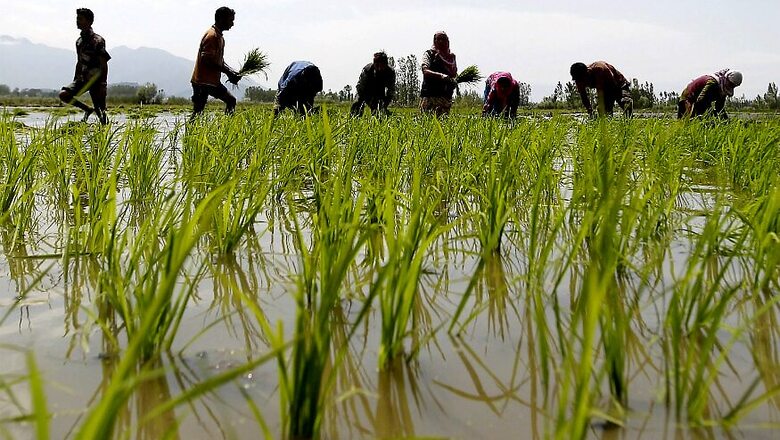
views
As elections near, some sort of “lollipop” may be coming for farmers.
There has been a persistent buzz about a package for farmers by the Narendra Modi government, and it has only grown louder over the last few days.
There is little likelihood of this package being another loan waiver scheme, given the contempt the Centre has shown over some opposition-ruled states implementing mega loan waivers in recent months. So while the contours of any such package are yet to be known, it may be a combination of an income guarantee scheme and a direct transfer benefit.
A report in Business Today quotes sources as saying that there could be a direct benefit transfer (DBT) for farmers worth Rs 4,000 per acre per season plus interest-free crop loan up to Rs 1 lakh per farmer. The initiative could cost the Centre Rs 2 lakh crore towards DBT and another Rs 28,000-30,000 crore towards interest subvention.
Whatever be the contours of the new scheme, one needs to remember that the Modi government has already tried several measures to please farmers but with middling success and experts have panned these schemes as being repackaged versions of existing schemes.
So apart from wholesale increase in the minimum support price (MSP) of a range of crops over the last few years, this government also launched schemes such as the Pradhan Mantri Annadata Aay Sanrakshan Abhiyan (PM-AASHA).
This was a mix of three mini-schemes: direct procurement from farmers (price support scheme or PSS), reimbursing them for losses incurred when wholesale market prices fall below the announced MSP (price deficiency payment scheme or PDPS) and a pilot project for procurement by private traders at MSP for the government.
Then, the Pradhan Mantri Fasal Bima Yojana already exists besides some other suitably named schemes too. How much these schemes are actually helping the farmer isn’t clear.
A closer look at the PM-AASHA shows it came about after a significant increase in the MSP for kharif crops, including paddy and pulses earlier this year. The government had claimed that the new MSP rates was the steepest ever increase and aimed at offering farmers a 150% return on their input costs on each crop. Input costs included household labour. In some cases, the government offered well above the promised 50% over input cost price, in one case it offered over 90% of the input cost price.
MSP serves as a floor price in wholesale agricultural markets, but a higher MSP does not automatically lead to an increase in farmers’ incomes. The penetration of the MSP system is just 5-6%, so an overwhelming 94-95% of the farmers remain out of the MSP net anyway. Even for those farmers who manage to sell at MSP, unless their produce is procured by the government, the entire effort is wasted.
Hence, the emphasis on widening procurement through PM-AASHA was pertinent. The pilot proposed for private parties to conduct procurement of oilseeds would have ensured better procurement in those states where oilseed production was considerable, including Rajasthan, Madhya Pradesh and Chhattisgarh.
But farmer representatives even then had called out these schemes as being repackaged versions of earlier schemes. They had pointed out that PDPS, for example, was nothing but the ‘Bhavantar Bhugtan Yojana’ already in force in Madhya Pradesh. The market intervention scheme also existed anyway with NAFED.
How are states tackling farm distress? Apart from loan waivers, here’s what they have:
Telangana’s Rythu Bandhu Scheme: The state government provides Rs 8,000 per acre for two crops to every farmer as investment support for purchase of inputs like seeds, fertilisers, pesticides and labour. An estimated 5.7 million farmers are covered under the initiative and the total burden on the exchequer is around Rs 12,000 crore. Main criticism of the scheme is that around 1.5 million tenant farmers aren't covered under it. Besides, doesr direct income support compensate fully for fall in prices, this is not clear.
MP’s Bhavantar Bhugtan Scheme: The state government promised a price differential in case prices of select kharif crops crashed on a pilot basis, without promising actual procurement of these crops. Experts have panned this scheme too, saying private players formed cartels to depress market prices so that the government handout can be obtained under this scheme. The government had to then pay a higher differential, defeating the purpose of the scheme.
West Bengal’s Farmer Initiatives: These include free crop insurance, higher compensation in case of farmer deaths, and Rs 5,000 assistance per farmer for growing a single crop in each acre of land each year.
Odisha: The state government has recently announced a package worth Rs 10,280 crore spread over three years. This scheme envisages financial assistance of Rs 5,000 per farmer at the start of every cropping season, besides livelihood assistance of Rs 12,500 to every landless family; interest-free loans of up to Rs 50,000, insurance cover of Rs 2 lakh for each and an additional accident cover of Rs 2 lakh.
These schemes by states are of course, in addition to mega farm loan waivers which have already been announced by both, BJP and Opposition ruled states. An analysis by CARE Ratings shows nine states have announced waivers since April 2017, with Andhra Pradesh giving the biggest waiver at Rs 43,000 crore and Tamil Nadu the smallest at Rs 5,780 crore.
For, any fresh package to assuage furious farmers — whether it be an income guarantee or DBT or another loan waiver — in the end, the government will have to find ways to fund the extra expenditure, stretching its fiscal math further.
(Author is a senior journalist. Views are personal)
















Comments
0 comment